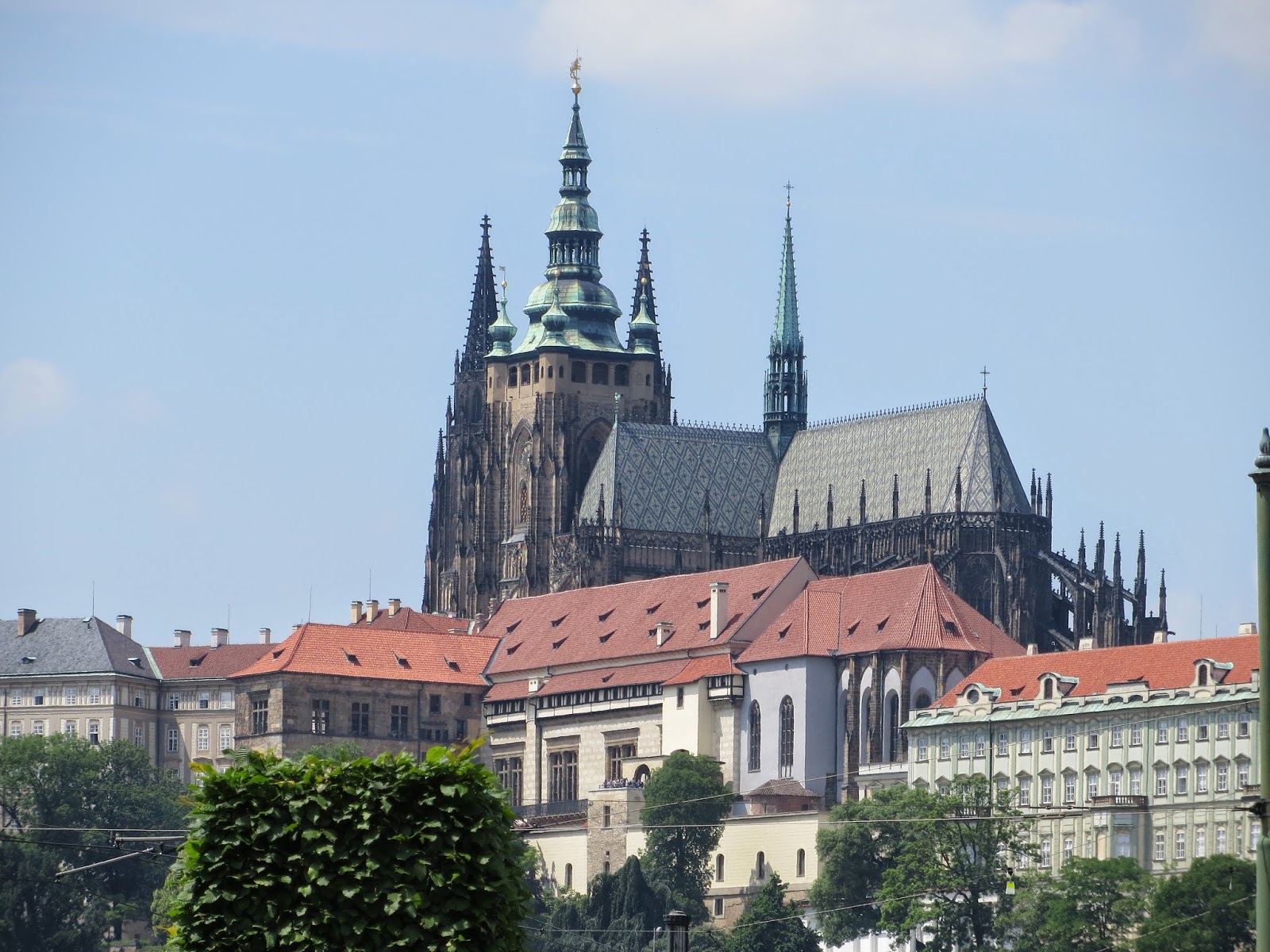Dominating the skyline above the river is the Prague Castle.
The castle is said to be eleven football fields in size and is still the seat of the government today. The central building in the complex is St. Vitus Cathedral.
So following our walking tour we crossed the river and headed uphill. Along the way we had a stop for lunch at a lovely vineyard restaurant.
The local wines were surprisingly tasty as was the local cuisine. We ate, drank and rested a bit before heading upward.
Spying a large mirror for trafic viewing, we found a new way to take a selfie.
Much of the original wall surrounding the castle remains today.
The grounds include the castle, the cathedral, an old lane of original housing, another church and various smaller sites. As you enter the guards keep watch.
The most imposing part of the complex by far is the cathedral. The cathedral is the largest and most important church in the Czech Republic and contains the tombs of many Bohemian kings and Holy Roman Emperors. Construction was begun in 1344, and continued until it was finally finished nearly 600 years later in 1929.It is nearly impossible to get a full view photo of the cathedral due to it's size and the proximity of the surrounding building. But each of the elements is extraordinary in its own right.
The doorway with the mosaic of the Last Judgement over it is the entrance the kings and emperors used to enter for their coronations.
Upon entering, the height and magnitude of the cathedral can take your breath away.
As you begin to walk around this vast expanse, there is so much to see. Each of the stained glass windows is unique.
There are graves and shrines and statuary.
The pulpit itself is a work of art from every angle.
There are many saints, Kings and Emperors buried in the cathedral. The royal crypt is not open for public viewing, but there is still much to see.
There are old time confessionals.
And dozens of unique side altars ring the center apse.
Some of the areas we were not sure of, but most seemed to be tombs or tributes to the many who are buried here.
Within the cathedral is the court treasury where valuable jewels and artifacts are housed. It is open to the public every eight years. This was not an eighth year.
There are statues and altars made of silver and tributes made of stone.
There is a side chapel where the coronation of Kings and Emperors were held.
And of course the organ was most impressive.
And this is just a small sampling of what is housed in St. Vitus.
The castle itself is enormous and was built is stages. The old castle is available for touring with no photos allowed. Unlike many of the castles which are filled with gold and art and statuary, this castle is much older and it is large, cold and sparsely furnished. It was build long before what we generally think of when the term castle is used. The exterior is much newer but the interior and the furnishings are barely changed from the original.
After the castle we went to the King's Lane. At first glance it resembles Daigon Alley of Harry Potter fame.
This lane is line with original homes and shops. Though it now houses more modern fare, some of the houses are recreated to look like the former days.
And the doorways were low and interesting.
We left the castle grounds just as the changing of the guard was taking place.
And then it was off to find a small cafe where we could enjoy the view and rest our weary feet. Just outside the cafe we saw one of the most interesting fountains I have ever come across.
What made this fountain most interesting is the fact that from waist to thigh of each gentleman rotates from side to side. Lots of grins among the tourists here.
The cafe we found was on the river front with peaceful views.
After our respite and some local shopping, we began a walk along the riverfront toward dinner. The swans were much bigger on this part of the river.
Our walk took us past one of the most iconic pieces of modern architecture in Prague. It is a building designed by Vlado Milunk and American Frank Geary called Dancing House. The name is derived from its curved lines and feeling of movement. Locals call it Fred & Ginger.
We had dinner in a quiet little neighborhood pub and then headed back to put our very tired feet up. Tomorrow is another day.


































































No comments:
Post a Comment